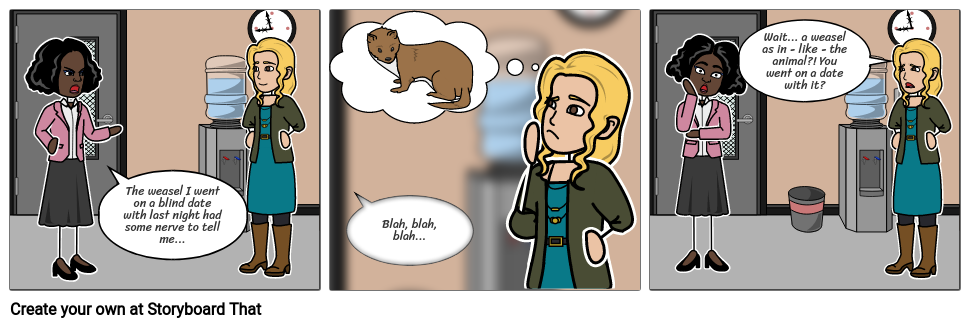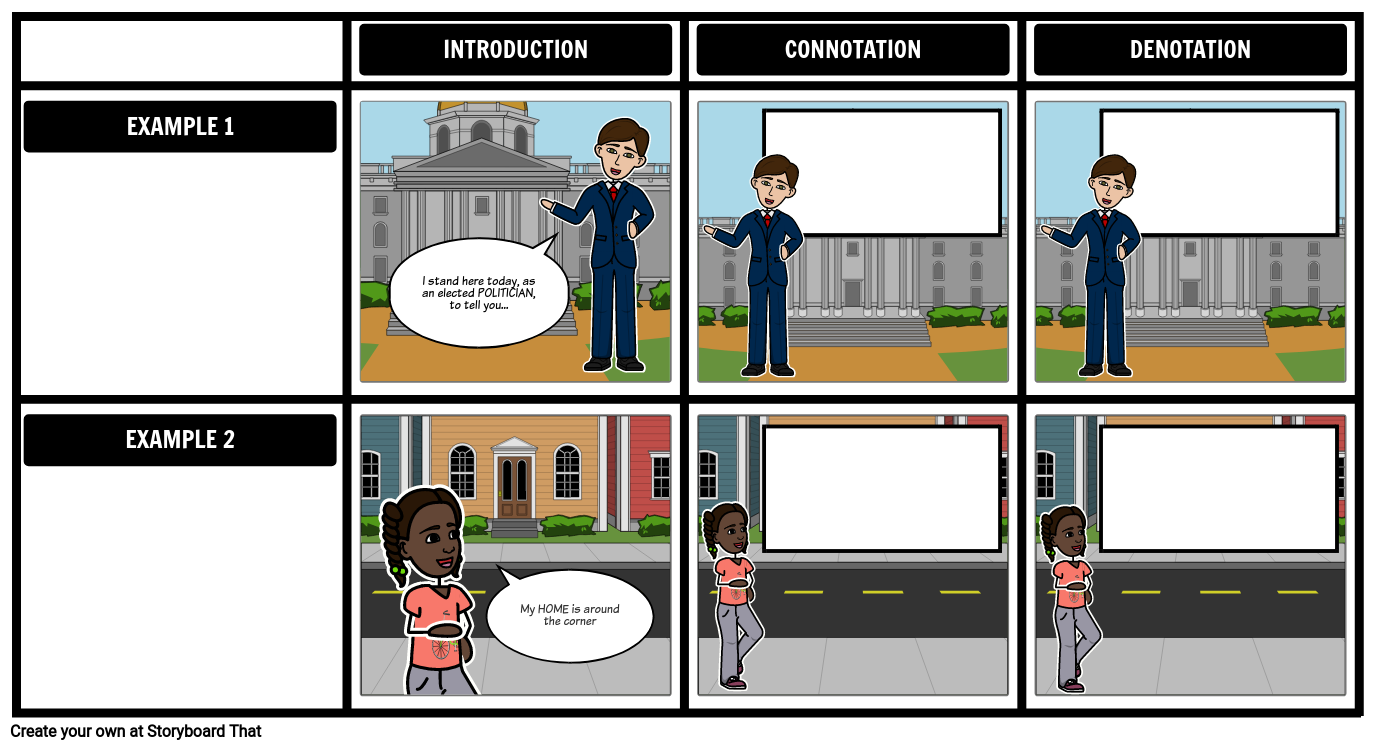English Review on Denotation Connotation & Figurative Language
https://www.storyboardthat.com/articles/e/connotation-vs-denotation
The Divergence Between Connotation and Denotation
The differences and nuances betwixt connotation and denotation are a popular topic to cover and review when discussing English grammar. Even after students are taught the difference in the early stages of learning, it is important to continue the discussion as discussion choice becomes more than imperative in the mastery of writing, and discussion recognition is increasingly of import to appoint advanced reading. In order for students to best empathize and apply the employ of tone in writing and literature, they must accept a firm grasp of the distinction between what words announce and connote.
Denotation is the strict, "dictionary" definition of a word. Connotation refers to the emotions and associations that attach to words, and aggrandize beyond their proper definitions. Poor word choice or misrecognition of wording can dramatically alter imagery, tone, mood, or bulletin of a piece. Revisiting the differences between the denotations of words and their connotations help students master their writing and reading.
Equally seen below, a misunderstanding tin quickly change the literal meaning of a message (every bit is the case with "weasel"). It can also change the tone of the message, consider the difference between feelings evoked by "mom" and "female parent". Some other denotation examples include words used to describe people like pig, chicken, bull, ox, or something like a instructor'south pet.

Showing Connotation and Denotation in Storyboards
Storyboards make a keen medium for practicing and demonstrating this semantic claiming. Whether you use them as non-linguistic representations of the concept, or you have students explore the concept themselves past using and/or creating storyboards, it volition strengthen their understanding of an of import reading and writing skill. Here are a few example activities:
- Model the problems of this semantic challenge by giving students storyboards of words with many connotations. Have students identify and talk over the nuances of the example.
- Provide a template storyboard for quick and easy practice (see example below). Your template tin have a specific word filled in, and students tin can consummate the board with their own word choices. In an practice like this, students see the varied emotions and ideas fastened to words. Variations:
- Utilise a specific word from context of a story to strengthen vocabulary
- Let students observe and exercise with words they explore
- Provide students with an opportunity to create storyboards demonstrating difficult or humorous utilize of words. The human activity of creating a storyboard has them focus and think critically about the discussion choice, and applicable demonstration of information technology.

Negative Connotation Examples
There are many words and phrases that we acquaintance negatively for diverse reasons, sometimes brought on from a minor number of examples, from a regional or cultural bias, or from past associations with the word. Accept a look at the examples below and write downward some of the first words you recall of. Are there negative connotations with any of those words?
Occupations
- Lawyer
- Politico
- Tax Collector
- Janitor
- Fast Food Clerk
- Secretary
Animals
- Craven
- Cow
- Ophidian
- Rat
- Sheep
- Toad
Adjectives
Common Core State Standards
The activities higher up help address numerous areas of the Mutual Core State Standards, in particular, standards in linguistic communication and writing.
- ELA-Literacy.L.9-10.3: Apply knowledge of linguistic communication to empathize how language functions in different contexts, to make effective choices for meaning or style, and to cover more fully when reading or listening
- ELA-Literacy.50.9-10.4: Decide or clarify the pregnant of unknown and multiple-meaning words and phrases based on grades 9-ten reading and content, choosing flexibly from a range of strategies
- CCSS.ELA-Literacy.50.9-10.4a Use context (e.g., the overall significant of a sentence, paragraph, or text; a word'south position or function in a judgement) as a clue to the meaning of a discussion or phrase.
- CCSS.ELA-Literacy.L.9-10.4b Identify and correctly use patterns of word changes that betoken different meanings or parts of spoken language (e.m., clarify, analysis, analytical; advocate, advocacy).
- CCSS.ELA-Literacy.L.9-ten.4c Consult full general and specialized reference materials (e.g., dictionaries, glossaries, thesauruses), both print and digital, to discover the pronunciation of a word or determine or clarify its precise meaning, its part of voice communication, or its etymology.
- CCSS.ELA-Literacy.Fifty.ix-10.4d Verify the preliminary determination of the meaning of a discussion or phrase (e.thou., by checking the inferred meaning in context or in a dictionary).
- ELA-Literacy.L.9-ten.5: Demonstrate agreement of figurative language, word relationships, and nuances in word meanings
- CCSS.ELA-Literacy.50.9-10.5a Translate figures of spoken language (east.g., euphemism, oxymoron) in context and analyze their role in the text.
- CCSS.ELA-Literacy.L.9-x.5b Analyze nuances in the meaning of words with similar denotations.
- ELA-Literacy.West.9-10.4: Produce clear and coherent writing in which the development, organization, and fashion are appropriate to job, purpose, and audition. (Class-specific expectations for writing types are defined in standards ane–3 higher up.)
- ELA-Literacy.Westward.nine-x.half dozen: Use engineering science, including the Internet, to produce, publish, and update individual or shared writing products, taking advantage of technology's capacity to link to other data and to display information flexibly and dynamically
Find more activities like this in our Heart Schoolhouse ELA and High School ELA Categories!
Schedule a complimentary Guided Session with the states to become a Storyboard That pro!
*(This Will Start a 2-Week Free Trial - No Credit Bill of fare Needed)
https://www.storyboardthat.com/articles/e/connotation-vs-denotation
© 2022 - Clever Prototypes, LLC - All rights reserved.
Source: https://www.storyboardthat.com/articles/e/connotation-vs-denotation
0 Response to "English Review on Denotation Connotation & Figurative Language"
Post a Comment